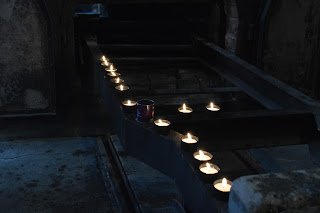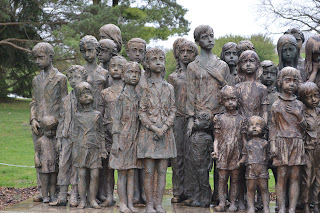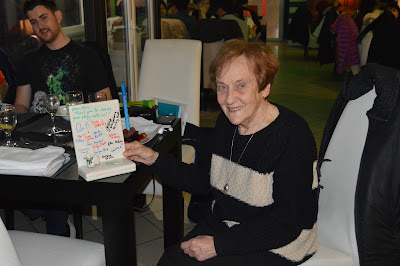Today after breakfast we
headed out on a cool, rainy day for Terezin and Lidice, accompanied by a Czech survivor, Doris
Schimmerlingova Grozdanovicova who would
tell us her story in Terezin, a garrison town which became a
concentration camp, renamed and known during the Holocaust as Theresienstadt. Doris had accompanied us last year and we
were thrilled to again have her join us and share her story. Today was Doris’ 91st birthday,
she told us. “I did not think I would be
spending it in Terezin”, she said, “but I’m so happy to be with you.”
On our way out of the city,
we passed a memorial with 3 paratroopers.
Shalmi told us of the Czech partisans from the resistance who had
parachuted into Czechoslovakia with the goal of killing Reinhard Heydrich in a
mission called Operation Anthropoi.
Heydrich was a top level Nazi who had helped organize Kristallnacht, was
responsible for the Einsatzgruppen (mobile killing units in Eastern Europe],
had chaired the Wannsee Conference in January 1942 to plan the implementation
of the Final Solution, and had been placed in charge of this part of
Czechoslovakia, known as Bohemia and Moravia.
The plan was to ambush his car at a curve along the route in Prague that
he regularly took and kill him. On May
27, 1942, one paratrooper jumped in front of the car as planned but his machine
gun would not fire, a second then lobbed a hand grenade into the car, killing
the driver and mortally wounding Heydrich.
He would die of his wounds on June 2, 1942. So the man in charge of the Final Solution
died at its very first stages, we were told, and all that remained of him was
his name. The eliminated of the Polish
Jews would be called Operation Heydrich.
The three paratroopers would
be hunted down by the Nazis where they were located in the crypt of the Church
of Saints Cyril and Methodius, an Eastern Orthodox church in Prague . The
Nazis tried to smoke them out and even tried to flood the crypt in an effort to
take them alive. The resistance fighters
chose to commit suicide rather than surrender.
Later, the bishop of the church and all top level clergy would be
arrested and executed as collaborators, for hiding the paratroopers. Our last stop today, Lidice, would also be
linked to this event.
On the bus ride, Shalmi gave
us some historical context for what we would be seeing. Terezin was one of those sites which was part
of both Phase 2 ‘Concentration and Ghettoization’ and Phase 3 ‘Annihilation’
about which we had heard at the Wannsee House in Berlin. Germany had been given the Sudetenland
section of the country in September 1938 at the Munich Conference because it was largely populated by ethnic
Germans. The National Socialists in
Slovakia led by Josef Tiso were told they would be supported by the Nazis if
they separated Slovakia from Czechoslovakia which they did in March of 1939,
becoming an Axis Power ally. The German
army then marched into and occupied the remainder of Czechoslovakia which they
renamed Bohemia and Moravia. There were
120,000 Jews in Bohemia and Moravia and the Nazis needed a place to concentrate
them until they decided what to do with them.
Terezin would provide this temporary solution. Shalmi said it could be
thought of as a ‘parking lot’.
Czechoslovakia was different from Poland, also, in that while Polish
Jews were concentrated in multiple ghettos, here there was but one: Terezin.
Terezin was an existing
walled in city outside of Prague which had been a garrison town established under
Emperor Joseph II and named after his mother, Maria Theresa, to house the
families of the soldiers who would be stationed at the Small Fortress
nearby. Under German occupation, Terezin
would be renamed Theresienstadt, the town would become the ghetto and the small
fortress would become the concentration camp.
Theresienstadt would last from its establishment in October 1941 until
its liberation at the end of the war, making it one of the longest lasting institutions
established by the Nazis during the Holocaust.
Jews would be gathered in Terezin, guarded by Czech police and monitored
by Nazi officials,. Internally, the
ghetto would be under Jewish management, with a Judenrat (Jewish Council) and
Jewish police.
At the ghetto museum we
watched a film which included video clips of the propaganda film created by the
Nazis called “A Gift of a Town” in which they had tried to dispel rumors of
deplorable conditions in the ghettos which had been created by the Nazis. These scenes were juxtaposed wth powerful
artworks secretly drawn by artists in the ghetto depicting the true conditions
of overcrowding and hunger, while a narrator reads transport records, such as
“Transport AA, Auschwitz, 1,000 people, 2 survivors, Transport AK, Treblinka,
1,000 people, no survivors,” etc.
At a model of the town,
Shalmi showed us the layout and talked about the organization of the
ghetto. Terezin was different in that
families were not housed together. One
of the first decisions of the Judenrat was to keep men and women and children
separated, both for space reasons, and, in the case of the children, to protect
them.
As we walked up the stairs to
the exhibition, we stopped on the stairs which were surrounded by pictures
drawn by the Terezin ghetto residents.
Shalmi pointed out two which he found particularly telling. In one there was a woman in a fur coat,
digging in a pile of dirt, looking for potatoes. This pointed out the ‘absurd’, he said. In another, a room is shown with family
members gathered, playing instruments.
In the corner, an older man sits, with an expression of “What is this
all about?” In all this uncertainty, his
family is playing music --- a paradox – as Shalmi has so often mentioned to us.
We then walked through the
exhibition with Shalmi and Kamila and Doris pointing out exhibits of special
interest, including the children’s art, a picture of Doris with her sheep (her
story will be told later) and even a large exhibit which listed all of the
transports to and from Theresienstadt.
Doris showed us where her transport was listed, Transport U arriving
January 28, 1942. She was 16 years old
and would spend her next 3 birthdays in Terezin.
Shalmi also told us of the
Red Cross visit to Terezin because of the Danish Jews. In October 1943 the Germans were planning to
round up the Danish Jews, but news of the impending roundup was leaked and of
its 8,000 Jews, Danes were able to smuggled all but 400 into Sweden and
safety. The Germans did find 400, however. The Danish Foreign Minister wanted to know
where they would be taken and the Germans told him Terezin. The Danish Foreign Minister then told the
Germans he would be visiting the Danish Jews in Terezin along with
representatives of the Red Cross.
Knowing of this impending visit and taking it seriously for some reason
(Shalmi noted the absurdity that they would be concerned by such a visit while
at the same time they were murdering thousands of Jews each day in Auschwitz),
the Germans proceeded to prepare the ghetto for their arrival. They began a
‘beautification’ process up sprucing up the ghetto: painting the buildings, planting flowers,
providing more food, and making the propaganda film we had seen. They also reduced the ghetto population,
sending two transports of 5,000 Jews to Auschwitz where, instead of being
gassed, they were held in a special area, known as the Terezin or Czech Family
Camp. The Red Cross visit happened – a
very superficial visit in which there was no effort made to find out the real
conditions in the camp. The Red Cross
then issued a report saying there was basically nothing wrong happening in
Terezin. A day after the visit, we were
told, the Czech Family Camp in Auschwitz was liquidated and all were murdered
in the gas chambers. Fifty years later,
Shalmi said, the Red Cross officially apologized for its report on Terezin.
We then walked to a building
in the ghetto, a hidden prayer room which had been constructed by the Danish
Jews who had been sent to Terezin in October 1943. Known as the Danish synagogue, it was
discovered about 15 years ago. Shalmi
told us that the prayers on the walls reflected the heartbreaking dialogue of
the Jews with their God. Verses such as
“We beg you, turn back from your anger and have mercy on the treasured nation
that you have chosen” and “But despite all this, we have not forgotten your
name. We beg you not to forget us” were
written on the walls. Shalmi said it was
known from testimony that there were at least 5 such prayer places for Jews and
5 for Christians in the ghetto. Why
Christians? Because many people had been
labeled as Jews who did not consider themselves Jews. Many people had converted, but if they had
one Jewish grandparent, the Nazis considered them Jewish still.
Next we walked to the
Magdeburg Barracks which had housed the Jewish Council, leaders of the ghetto
administration. Here, Doris told us her
family’s story. She was born in the
Czech town of Brno, and in 1942, she, her mother and father and older brother
were all sent to Terezin. Her mother
would die in Terezin; her father and
brother would be transported to Auschwitz where her father would be
murdered. Three months after the end of
the war she would be reunited with her brother.
Doris said she was lucky because
she was assigned the role of herding sheep.
This kept her outdoors in fresh air and she was housed in separate
quarters from most of the girls. She
believes her working with sheep kept her alive.
“I have a collection of sheep today,” she said. “Over 900.
People are always giving me sheep.
Not alive of course.”
Shalmi then led us through
the exhibition, which included a typical dormitory room, and sections devoted
to the art, music, literature and theatre which ghetto residents left behind as
their legacy. We listed to the victory
song from the children’s opera, Brundibar, written by Hans Krasa and performed by
children in the ghetto, viewed pictures by ghetto artists, and read some of the
poetry and literature left by residents of the ghetto, their legacy to us. Shalmi asked us to think about this. Daily life could include soccer games, a
children’s opera, a newspaper, Vedem,
written by the boys in Terezin, art lessons, and concerts, and yet every day
individual people disappeared. How do
you reconcile these two things: the
creation of culture alongside the destruction of people. We reminded of the term ‘Kafkaesque’ that we
had discussed previously. Kafka was
considered the father of Holocaust literature although he died in 1924. Shalmi said that Kafka wrote about the absurd
and that the Holocaust was not only about brutality, it was also about the
absurd and surreal, especially from the point of view of the victims. He told us of one of Kafka’s short stories, The Trial, in which a man is arrested,
tried, convicted and executed without ever being told what crime he was being
accused of having committed. The Jews,
similarly, could not understand what they were guilty of. In the music room Shalmi translated a page
from the diary of Rafael Schachter
[1904-1944] in which he spoke of the cold, food, a concert performance,
transports to the east, and his room becoming nicer. “Beyond Kafkaesque”, Shalmi said.
In Terezin we walked through the crematoria where they cremated bodies of ghetto residents due to malnutrition and disease.
Next we headed to our last
stop in Terezin, the Small Fortress
where Shalmi spoke to us of the purpose
of concentration camps. Its function was to create conformity. People who were political opponents of Nazism
were brought here to re-educate them and bring them into line. In these places
your identity was taken away, you were never given enough food so there was
constant hunger. The camp was about
submission and survival until one had undergone the change from a person to an
object. Jews were not placed in
concentration camps for the most part, because the Jews, according to Nazi
ideology, were a race of people and there was nothing that could be done to
change that through a process of re-education.
After walking into the camp under the iconic phrase “Arbeit Macht Frei”,
Shalmi showed us the military barracks room, the delousing room, shower room
and shaving room.
In June 1942, Heinrich Heydrich
had been assassinated in Prague and the Nazi leadership wanted someone to
pay. Lidice was a small town outside of
Prague with about 500 inhabitants. On June 10, 1942 the Nazis descended upon
this small town in the mistaken belief that the residents had aided the
paratroopers responsible for Heydrich’s assassination. The men were all shot, the women were sent to
Ravensbruck, very young children who could pass as Aryans were sent to Germany
to be raised by German families, and 82 children who were older or who looked
non-Aryan were transported to Lodz and then later to Auschwitz where they were
murdered.
The Lidice memorial is to the
memory of the 82 children. The memorial was designed by sculptor Marie
Uchytilova. It is a bronze monument
which depicts each of the 82 children from photographs. There are 42 girls and 40 boys who look out
over what used to be their village. The
last child sculptures were unveiled in 2000 so that the memorial is now
complete. It is an extremely powerful
memorial that made a significant impact on us.
We next walked through the Lidice museum which depicts the assassination
of Heydrich, the hunt for his killers, life in Lidice, and the massacre and destruction
of the town. One of the most haunting
items in the exhibit was a school picture taken of the children eight days
before the tragedy. Before exiting,
there were powerful video testimonies of both mothers who had survived but lost
their children, and children who had been orphaned.
We then returned to Prague
and had a wonderful dinner at one of our favorite restaurants, Restaurant
Nebozizek which is on Castle Hill overlooking Prague with spectacular views of
the city. We were joined by Doris and Dana Brichtova who is owner of DAIDO travel
agency in Prague and who has been such a wonderful organizer of our trip for us
and become such a dear friend. Our trip
would never be as successful as it had been without all of her assistance and
we are so indebted to her for her expertise and kindnesses. After another outstanding dinner and a
birthday celebration for Doris, with our gift of another sheep to add to her
growing collection, we said goodbye to her,
thanking her for graciously spending the time with us and enriching our
understanding of the events in Terezin and returned to the hotel to debrief and
start packing as we were leaving Prague early the next morning.














































I remember standing in front of the Lidice memorial like it was yesterday. Hard to believe it was 2 years ago, but I'll never forget the emotions and insight I walked away with. Catching up on all the posts and I feel like I'm reliving my own experience. Looking forward to reading the days to come!!
ReplyDeleteThose getttos were before jews were sent to conserotation camps were there last hope of servival.
ReplyDeleteThere is just so much history there. It's interesting.
ReplyDeletenew york yankees tickets
cheap new york yankees tickets
Those people made great sacrifices.
ReplyDeletesecure airport parking Manchester
Manchester parking deals